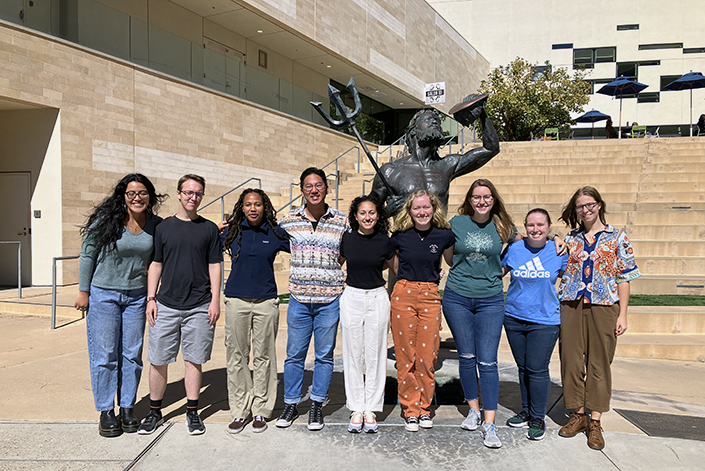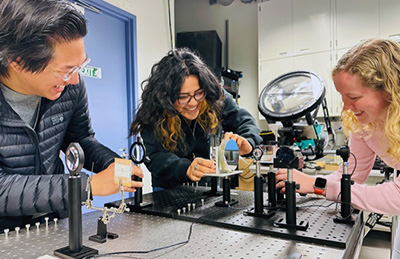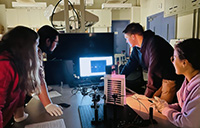UC San Diego Launches a Stellar Ph.D. Program in Astronomy
Story by:
Published Date
Article Content
Years in the making, the University of California San Diego has announced a new graduate program in astronomy and welcomed its first full cohort of students last fall. The program provides students the opportunity to participate in cutting-edge astronomical and astrophysical research with access to a range of national and international observatories and facilities.
Until now, UC San Diego graduate students interested in astronomy enrolled in a physics doctoral program with an astronomy specialization. This meant they were required to take mostly physics-based classes with only room for a few courses related to astronomy or astrophysics. The new astronomy Ph.D. program provides a rich set of courses dedicated to astrophysical research training. Now, with a standalone graduate program, the equation is flipped: students take a majority of astronomy courses, supplemented with a few classic physics classes.
“The new astronomy Ph.D. degree program will provide graduate students with an opportunity to receive more specialized training and curriculum in astronomy and astrophysics,” stated Dean of the Division of Graduate Education and Postdoctoral Affairs James Antony. “This exciting new degree offering will further establish UC San Diego as a destination for intellectually stimulating graduate education and research in the field of astronomy, improving our competitiveness to recruit talented and diverse students to our campus.”
A committee of astronomy and astrophysics faculty continues to work together to fully develop and evaluate the many aspects of successfully implementing a graduate program, including course development, admissions and student success.
“We still have much work ahead on refining the program,” stated Professor of Physics Shelley Wright, who is also the inaugural vice-chair for astronomy. “We look forward to working with our graduate students on ways we can improve courses and strengthen our community."
Charting Your Own Course
A full range of astronomical classes are already being taught, including newly developed classes Survey of Astronomy, Astronomical Instrumentation and Observational Techniques, and Planets and Exoplanets. There are also several theory courses that cover everything from the evolution of stars and galaxies to the properties of black holes. Computational courses are being developed that will cover galaxy simulations, cosmology simulations and stellar evolution.
Undergraduate astronomy programs are relatively rare, so students in the Ph.D. program will arrive with varying backgrounds in the field. The program is designed to bring all students up to speed in astronomy, while also providing opportunities for deep dives in specific subject areas. Associate Professor of Physics Karin Sandstrom, who teaches the first-year Survey of Astronomy course, said, “One of our main goals is making sure that students from a variety of backgrounds, including those from colleges without undergraduate astrophysics courses, can thrive in our program.”


Classroom instruction is one critical component. Preparing graduate students for research is another. Many graduate programs conduct an assessment after the first or second year of a program to make sure students are progressing adequately, and often that assessment is exam-based. The astronomy graduate program is creating a research-based qualification focused on the completion of a project.
“It’s not just a theoretical exercise,” stated Professor of Physics Adam Burgasser. “It’s a practical application that could lead to the start of a thesis or a published paper. We don’t want graduate students to just excel at taking classes. We want students who can go out there and do the research.”
The focus on research is one of the things that drew Preethi Karpoor to the program. “UC San Diego has a great legacy of producing some of the finest research and researchers, and this program puts a lot of focus on developing your skills as a researcher,” she stated. “I’m interested in trying to adapt the latest technologies to unveil the deeper secrets of the universe as efficiently and eloquently as possible.”
A New Way of Recruiting
Designing a new graduate program allowed the committee to create a recruitment process with equity, diversity and inclusion (EDI) at its core. This meant developing a more holistic admissions process with nontraditional rubrics and evaluation metrics.

“There’s been a lot of deep thought about diversity issues in our community writ large. Within this graduate program, we have a shared ethos that this is an important part of who we are and what we want to do as professionals,” said Burgasser, who is also admissions chair for the program.
How is this ethos put into practice? In addition to a strong academic record, the evaluation rubric looks at community activities like public engagement and EDI contributions. A major part of the rubric evaluates non-cognitive capacities, such as initiative, leadership and overcoming adversity.
“We explicitly look for evidence of these traits in the applications, because research shows that they are well-correlated with success in graduate programs,” stated Burgasser. “I don't know of any graduate student who doesn't have some hiccup in their degree program — including myself — so the ability to overcome adversity is something that's going to help.”
Research has also shown that these non-cognitive capacity metrics are more equitable than standardized testing where you might lose an entire demographic of applicants due to testing biases. The goal is to implement evaluation metrics that are both effective at predicting graduate outcomes and are also equitable.
Ad Astra — to the Stars
The new astronomy graduate program joins a crop of such programs that are capitalizing on humanity’s enduring love affair and fascination with outer space. Over the past several decades, the capabilities of space telescopes have increased exponentially. The James Webb Space Telescope (JWST) launched in 2021 and has already returned jaw-dropping images of the universe.
“The next generation of astronomers will live in extraordinary times with JWST, the Roman Space Telescope, the Rubin Observatory, and many other future facilities,” stated Sandstrom. “Graduate students today will be the ones who eventually discover amazing things with these telescopes. At UC San Diego, we are immensely excited to foster their future careers.”
Graduate student Jayke Nguyen is equally excited about UC San Diego. His research interests lie in exoplanet detection and adaptive optics. Asked what he likes most about the program, he replied, “The people here are wonderful. All the professors in the program are excellent. Everyone is always willing to help out, and your voice is always heard.”
Karpoor concluded, “This astronomy program is one of a kind.”
Share This:
You May Also Like
Stay in the Know
Keep up with all the latest from UC San Diego. Subscribe to the newsletter today.



